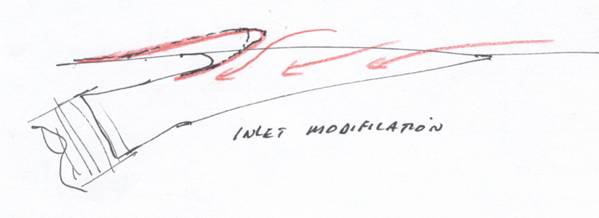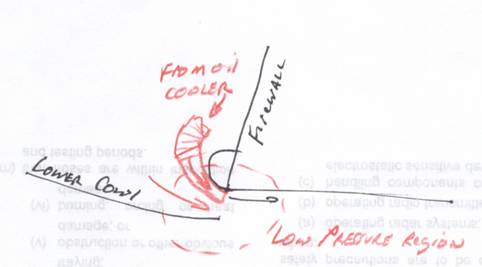Hi Randy:
Invariably the high oil temperatures come from inadequate air
flow through the oil cooler either due to inadequate pressure available to push
air through the cooler, or (effectively the same thing) too much friction in
the air flow delivered to the cooler which saps the pressure drop.
The ugly solution is to enlarge the NACA duct which is
probably too small to take in the air flow required. You need to deliver
more flow and ram pressure to the cooler.
As an interim measure, if you can go to a larger SCAT hose,
do it as the SCAT hose has a very high friction loss compared to smooth pipe
due to the corrugations inside. However from the pictures I suspect that
the choke point is the NACA duct and the throat within the NACA duct.
Less painful than a new NACA duct is to put an extension on
the NACA duct to scoop in more air. The idea is to reach outside of the
boundary layer and scoop in some high speed air from the free stream.
This should improve the ram pressure and thus the pressure drop available
across the oil cooler. Make something of foam and fibreglass putting some
release tape on the cowl and inside of the NACA duct so the fibreglass can be
pulled off and finished, trim, and then fit with duct tape initially to test.
Once you get something that works, you can paint and perhaps attach the new
raised inlet lip with a couple of screws or adhesive and not have to fiddle
with the cowl or cowl paint. Some experimentation will be required. See
sketch below.

Another possibility that avoids fiddling with the cowl but
which will be more work is to put a plenum on the oil cooler discharge
and carry the hot air oil cooler exhaust to a low pressure discharge point to
improve the delta P across the oil cooler. The lowest pressure point
would be at the cowl hot air exit. As the hot cowl air accelerates out
the exhaust duct and out the belly, velocity rises and static pressure falls. If
you can discharge the oil cooler air at that location, you will get a bit of suction
that improves the air flow through the oil cooler. See sketch below.

Let us know what you tried and if it works.
Fred Moreno
-----Original
Message-----
From: randy snarr
[mailto:randylsnarr@yahoo.com]
Sent: Saturday, 7 March 2009 9:54
AM
To: lml@lancaironline.net
Subject: oil cooling
All,
I am looking for suggestions on how to lower my oil temps. I am running an IO
320 on the original 235 frame. On warm days in a climb I have trouble keeping
them below 220. I usually have to flatten out the climb to cool things down
if they get up to 230 or so. Once in cruise it is not a problem and they will
settle around 210. I would like to get them down to 190 if possible. The
problem is on a 75 plus degree day when the airplane is already warm from
flying and I need to go again. I am picking up outside air on a naca vent on
the left side of the cowl. There is a 6" length scat tube
(4"diameter) connecting the cowl inlet to a glass expansion section that
is connected to the cooler.(see pics). It just dumps in the lower cowl area.
I am running a Stewart Warner oil cooler that many have had success with.
I have tried larger hoses to the cooler now using -8's and also removed the
90 deg fittings I used to have to improve flow.
I suspect my ducting and or connection to the cooler could be improved. I am
looking for suggestions that could be done without cutting the cowl.
Thanks in advance!
Randy L.Snarr
|